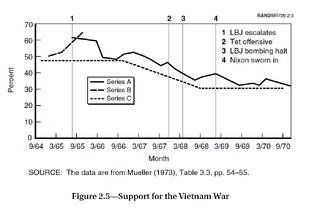|
|
| Untersuchte Arbeit: Seite: 168, Zeilen: 2-10, 101-113 |
Quelle: Larson 1996 Seite(n): 24, 25, Zeilen: 24:9-23.101-113; 25: figure 2.5 |
|---|---|
| The public opinion polls on Vietnam consistently reinforced this argument. Mueller found a “rally in support at the beginning of the war and high levels of public support into 1966. By mid-1966, however, support had declined in the wake of such events as infighting among the South Vietnamese and the emergence of vocal criticism of the war during the Fulbright hearings in early 1966. By this time, the public had also come to see that the war would not be over quickly but was instead likely to be a “long, bloody affair.”56 The figure below shows the course of public support for the war.57
SOURCE: The data are from Mueller (1973), Table 3.3, pp. 54–55. American forces in Southeast Asia gradually increased to over half a million. By the time of the 1968 Tet offensive, support for and opposition to the war had [hardened to a point at which events on the battlefield or in Washington were less likely to make an impression; support for the war was down to hard-core supporters and fell only an additional ten points thereafter.58] 56 John Mueller, Public Choice (Cambridge: Cambridge University Press. 1973), p. 56. Mueller cites a Harris/Newsweek poll showing that the percentage expecting a long war had increased from 54 to 72 percent between the end of 1965 and mid-1966. 57 Data are from Mueller, pp. 54-55; reprinted from Eric Larson, Casualties and Consensus: The Historical Role of Casualties in Domestic Support for U.S. Military Operations (Santa Monica, CA: RAND, 1996), p. 25. Question wordings for the four series are as follows (all reported in the American Index of Public Opinion). Series A: “In view of the developments since we entered the fighting in Vietnam , do you think the U.S. made a mistake sending troops to fight in Vietnam?” Series B: “Some people think we should not have become involved with our military forces in Southeast Asia, while others think we should have. What is your opinion?” Series C: “Do you think we did the right thing in getting into the fighting in Vietnam or should we have stayed out?” In 1964 and 1966, the question was asked only of those who said they had been paying attention to what was going on in Vietnam. [58 Mueller, p. 56.] |
[page 24]
THE VIETNAM WAR [...] Figure 2.5 shows the path of public support for the war.50 Mueller found a “rally” in support at the beginning of the war and high levels of public support into 1966. By mid-1966, however, support had declined in the wake of such events as infighting among the South Vietnamese and the emergence of vocal criticism of the war during the Fulbright hearings in early 1966. By this time, the public had also come to see that the war would not be over quickly but was instead likely to be “a long, bloody affair.”51 In the event, U.S. forces in Southeast Asia gradually increased to over half a million. By the time of the 1968 Tet offensive, support and opposition for the war had hardened to a point at which events on the battlefield or in Washington were less likely to make an impression — support for the war was generally down to hard-core supporters and fell only perhaps an additional 10 points thereafter.52 50Data are from Mueller (1973), Table 3.3, pp. 54–55. Question wordings for the four series are as follows. Series A (AIPO): “In view of the developments since we entered the fighting in Vietnam, do you think the U.S. made a mistake sending troops to fight in Vietnam?” Series B (AIPO): “Some people think we should not have become involved with our military forces in Southeast Asia, while others think we should have. What is your opinion?” Series C (NES): “Do you think we did the right thing in getting into the fighting in Vietnam or should we have stayed out?” In 1964 and 1966, the question was asked only of those who said they had been paying attention to what was going on in Vietnam. 51 Mueller (1973), p. 56. Mueller cites Harris/Newsweek poll showing that the percentage expecting a long war had increased from 54 to 72 percent between the end of 1965 and mid-1966. 52 Mueller (1973), p. 56. [page 25] SOURCE: The data are from Mueller (1973), Table 3.3, pp. 54–55. Figure 2.5—Support for the Vietnam War |
Not only the data, but also the wording has been taken from Larson [1996]. Larson is mentioned only once in passing in a footnote only with regard to a figure originating from Mueller. In fact the whole passage stems from Larson. No part from Larson has been marked as a citation. There is no closing quotation mark for the opening quotation mark in line 2. The illustration that Mec uses has the RAND mark in the upper right-hand corner, the publisher of Larson. Also cp. Kaczynski et al. (2017). |
|

